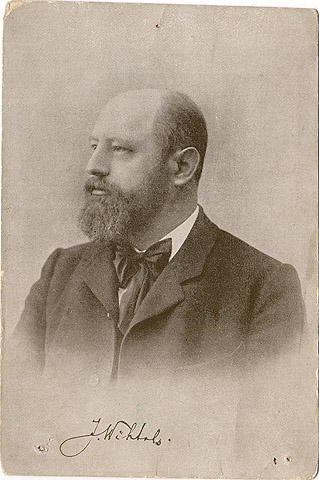
Jāzeps Vītol
Source: Fransvannes / Public domain via Wikimedia Commons
We begin with music by Jāzeps Vītols (1863–1948), the distinguished Latvian composer of some 850 works. Aged 17, he began his studies at the prestigious St Petersburg Conservatory, where his principal teacher was Nikolay Rimsky-Korsakov. After graduating, he himself joined the faculty; his students included Prokofiev, Miaskovsky and Shcherbachov. During his 32 years in St Petersburg, Vītols also became close friends with Anatoly Lyadov and Alexander Glazunov.
Vītols composed his 5-movement orchestral suite Dargakmeni (Jewels) in 1924 and dedicated it to Glazunov. Its five short contrasting movements are colourfully orchestrated: Amethysts, Emeralds, Pearls and Rubies are followed by the finale – Diamonds – that’s cast in the form of a bright, elegant waltz.
Diamonds (8.223756)
“It came to me that the soul is like a castle, a castle of diamond or very clear crystal. In this castle are a multitude of dwellings, just as in heaven there are many mansions.” Teresa of Avila (1515–1582)
This text served as the inspiration for The Castle of Diamonds, the fifth and shortest of seven movements in Luminosity by the British composer James Whitbourn. Completed in 2008, it was written for the unusual combination of choir and dancers. The focus in all the elements is on transcendent beauty and eternal love, while the libretto gathers together a collection of simple, profound and beautiful truths from luminaries down the ages, all exploring the timeless nature of creative love.
The Castle of Diamonds (8.572103)

Billy Joseph Mayerl
Source: Chandos.net
One of his ambitions was to popularise jazz, ragtime and syncopated piano playing in general. His style of composition reflected his multi-faceted career and rarely deviated; it quickly fell out of fashion, but has remained unsinkable to this day. Written in 1933, Mayerl’s Four Aces Suite reflects the penchant he had for card games. He used aspects associated with the different suits to characterise each movement. Music linked to games seems to have been in fashion at the time: four years later Arthur Bliss produced his score for the ballet Checkmate and Stravinsky for Jeu de Cartes.
Here’s Mayerl’s Ace of Diamonds.
Ace of Diamonds (8.223514)
Men grow cold as girls grow old
And we all lose our charms in the end.
But square-cut or pear-shaped
These rocks don’t lose their shape
Diamonds are a girl’s best friend!
Diamonds are a Girl’s Best Friend (ODE968-2)
Émile Waldteufe
Source: Archivio Storico Ricordi / CC BY-SA 4.0 via Wikimedia Commons
Waldteufel’s good-natured personality is reflected in his music of charming melodies and gentle harmonies. Understandably, but rather regrettably, his talent was overshadowed by the achievements of the Strauss family. He wrote what is probably his best known work Les patineurs (The Skaters) in 1882. The original title of the waltz chosen for this blog was Pluie de diamants (1879), which means not only ‘diamond rain’ but also ‘shower of diamonds’ such as might be suspended from a lady’s neck at any elegant Parisian ball. We hear the latter part of this sparkling waltz.
Pluie de diamants (8.553956)

John Barry
Source: Geoff Leonard / CC BY-SA 1.0 via Wikimedia Commons
The original soundtrack, as with the previous Bond films, was by John Barry; the vocalist for the title song was the incomparable Shirley Bassey. We end by listening to an orchestral arrangement of the piece by Dieter Reith.
Diamonds Are Forever (CD93.083)



1 thought on “The sound of sparklers.”